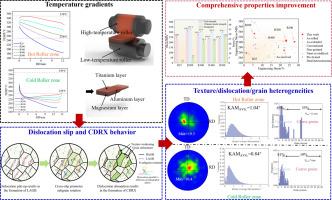Evolution of multiscale heterostructures and comprehensive properties improvement in the large thickness ratio Ti/Al/Mg clad plates under heterothermal rolling
IF 13.8
1区 材料科学
Q1 METALLURGY & METALLURGICAL ENGINEERING
引用次数: 0
Abstract
The preparation process of metal clad plates with large thickness ratios (>20) requires ensuring the substrate thickness while also achieving good mechanical properties, a challenge that traditional rolling processes struggle to meet. In this study, TA1/1060/AZ31 clad plates with large thickness ratios (>40) and engineered heterostructures were fabricated via heterothermal rolling, achieving synergistic enhancements in bonding strength and tensile properties. This is attributed to localized interfacial strain concentration induced by the temperature gradient, and sustained strain hardening within the multiscale heterostructured magnesium matrix. The study reveals that the temperature gradient variation in the normal direction of the matrix causes considerable gradation in its deformation mechanisms and microstructure, resulting in diverse heterostructures. In the hot roller zone, high temperatures and large strains promoted the formation of low-angle grain boundaries (LAGBs) with distinct distribution patterns. In contrast, deformation in the cold roller zone was stress-dominated, where the competition between tensile twins and 〈c+a〉 slip changed at low temperatures. Furthermore, LAGB evolution and 〈c+a〉 slip activity differences caused zone-specific variations in discontinuous dynamic recrystallization (CDRX), affecting dislocation density and grain refinement. The higher CDRX degree in the cold roller zone (soft domain) delayed failure in the hot roller zone (hard domain), while heterogeneities in grain size and texture enhanced strain hardening. The dense presence of 〈c+a〉 dislocations within grains further confirmed the continuous strain hardening behavior. This study provides new insights for the fabrication of metal clad plates with large thickness ratios and the development of novel heterostructures.

大厚比Ti/Al/Mg复合板在异温轧制下多尺度异质组织演变及综合性能改善
大厚度比(>20)金属复合板的制备工艺要求在保证基材厚度的同时又要获得良好的力学性能,这是传统轧制工艺难以满足的挑战。在本研究中,TA1/1060/AZ31复合板具有大厚度比(>40)和工程异质结构,通过异温轧制实现了结合强度和拉伸性能的协同增强。这主要归因于温度梯度引起的局部界面应变集中,以及多尺度异质结构镁基体内持续的应变硬化。研究表明,温度梯度在基体法向方向上的变化使其变形机制和组织发生了较大的梯度,形成了不同的异质结构。在热辊区,高温和大应变促进了低角度晶界(LAGBs)的形成,并具有明显的分布模式。冷辊区变形以应力为主,在低温下,拉伸孪晶和< c+a >滑移之间的竞争发生了变化。此外,LAGB演化和< c+a >滑移活度差异导致了不连续动态再结晶(CDRX)的区域特异性变化,影响了位错密度和晶粒细化。冷辊区(软区)较高的CDRX度延迟了热辊区(硬区)的破坏,而晶粒尺寸和织构的非均质性增强了应变硬化。晶粒内密集存在的< c+a >位错进一步证实了连续应变硬化行为。该研究为大厚度比金属复合板的制备和新型异质结构的发展提供了新的思路。
本文章由计算机程序翻译,如有差异,请以英文原文为准。
求助全文
约1分钟内获得全文
求助全文
来源期刊

Journal of Magnesium and Alloys
Engineering-Mechanics of Materials
CiteScore
20.20
自引率
14.80%
发文量
52
审稿时长
59 days
期刊介绍:
The Journal of Magnesium and Alloys serves as a global platform for both theoretical and experimental studies in magnesium science and engineering. It welcomes submissions investigating various scientific and engineering factors impacting the metallurgy, processing, microstructure, properties, and applications of magnesium and alloys. The journal covers all aspects of magnesium and alloy research, including raw materials, alloy casting, extrusion and deformation, corrosion and surface treatment, joining and machining, simulation and modeling, microstructure evolution and mechanical properties, new alloy development, magnesium-based composites, bio-materials and energy materials, applications, and recycling.
 求助内容:
求助内容: 应助结果提醒方式:
应助结果提醒方式:


